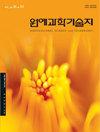Variability of Chrysanthemum Cultivars Induced by Gamma Irradiation
IF 0.8
4区 农林科学
Q3 HORTICULTURE
Korean Journal of Horticultural Science & Technology
Pub Date : 2021-10-01
DOI:10.7235/HORT.20210059
引用次数: 1
Abstract
This study aimed to determine the exposure dose of gamma radiation on stem cuttings of chrysanthemum cultivars. Explants of 11 cultivars (‘Eldora’, ‘Rania’, ‘Aileen’, ‘Olga pink’, ‘Sevda’, ‘Heimish’, ‘Rania’, ‘Attirance’, ‘White Plume’, ‘Coral King’, and ‘Leporem’) were subjected to different levels of gamma irradiation (0, 10, 30, 50, 70, 100, and 150 Gy). The results revealed that variation in vegetative growth parameters, viz., plant height, stem diameter, number of leaves, leaf length, leaf width, total number of flowers, flower diameter, number of petals, petal length and width, and number of buds occurred in the M1V1 generation compared to the control (0 Gy). The survival rates of the gamma-irradiated cultivars changed dramatically. The number of surviving plantlets based on 50% lethal dose (LD50) was found in 100 and 150 Gy treated plants 60 days after radiation. In addition, the highest percentage of plant survival was observed in the control, while the lowest percentage was observed in plants irradiated with 100 Gy and 150 Gy, along with delayed bud initiation and flowering. The number of days from planting to flowering was low in all of the control cultivars, even though the flowering percentage was high in the control compared to the treatments. The highest number of branches was observed in plants that were subjected to 100 and 150 Gy treatment, while 10, 30, and 50 Gy gamma irradiation revealed similar vegetative characteristics to all the control cultivars. Maximum leaf abnormality and leaf color variation were observed in the 70, 100, and 150 Gy treatments. Mutant varieties were produced from those treated with 10, 30, 50, 70, and 150 Gy, in which a higher number of mutants and mutation frequency were found in the 30 and 70 Gy treatments. The results showed that more flower color mutations occurred due to higher exposure to irradiation with minimum alteration in the vegetative growth in all cultivars. These results establish a standard to identify the gamma radiation dose that can induce mutations in chrysanthemum. Additional key words: flower color, growth parameter, lethal dose, mutation frequency, stem cutting, vegetative growthγ辐照对菊花品种变异的影响
本研究旨在测定γ辐射对菊花品种茎插条的暴露剂量。对11个品种(“Aldora”、“Rania”、“Aileen”、“Olga pink”、“Sevda”、“Heimish”、“拉尼娅”、“Attrance”、“White Plume”、“Coral King”和“Leporem”)的外植体进行不同水平的γ辐照(0、10、30、50、70、100和150 Gy)。结果表明,与对照(0Gy)相比,M1V1代的营养生长参数,即株高、茎径、叶数、叶长、叶宽、总花数、花径、花瓣数、花瓣长宽和芽数发生了变化。γ辐照品种的存活率发生了显著变化。在辐射60天后,在100和150Gy处理的植物中发现了基于50%致死剂量(LD50)的存活植株的数量。此外,在对照中观察到最高的植物存活率,而在100Gy和150Gy照射的植物中观察到最低的存活率,同时延迟了芽的萌生和开花。所有对照品种从种植到开花的天数都很低,尽管与处理相比,对照品种的开花率很高。在经过100和150Gy处理的植物中观察到最高数量的枝条,而10、30和50Gy的伽马辐射显示出与所有对照品种相似的营养特征。在70、100和150Gy处理中观察到最大的叶片异常和叶片颜色变化。用10、30、50、70和150Gy处理的突变体产生了突变体品种,其中在30和70Gy处理中发现了更高数量的突变体和突变频率。结果表明,在所有品种中,由于较高的辐射暴露量和最小的营养生长变化,出现了更多的花色突变。这些结果建立了一个标准来确定可以诱导菊花突变的伽马辐射剂量。附加关键词:花色、生长参数、致死剂量、突变频率、茎切、营养生长
本文章由计算机程序翻译,如有差异,请以英文原文为准。
求助全文
约1分钟内获得全文
求助全文
来源期刊
CiteScore
2.00
自引率
0.00%
发文量
0
审稿时长
1 months
期刊介绍:
Horticultural Science and Technology (abbr. Hortic. Sci. Technol., herein ‘HST’; ISSN, 1226-8763), one of the two official journals of the Korean Society for Horticultural Science (KSHS), was launched in 1998 to provides scientific and professional publication on technology and sciences of horticultural area. As an international journal, HST is published in English and Korean, bimonthly on the last day of even number months, and indexed in ‘SCIE’, ‘SCOPUS’ and ‘CABI’. The HST is devoted for the publication of technical and academic papers and review articles on such arears as cultivation physiology, protected horticulture, postharvest technology, genetics and breeding, tissue culture and biotechnology, and other related to vegetables, fruit, ornamental, and herbal plants.

 求助内容:
求助内容: 应助结果提醒方式:
应助结果提醒方式:


